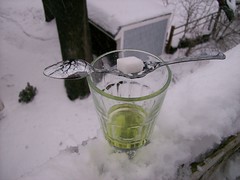Absinthe is historically described as a distilled, highly alcoholic (90-148 proof) beverage, says Wikipedia.
It is an anise-flavoured spirit (licorice-flavored) derived from herbs, including the flowers and leaves of the herb Artemisia absinthium, commonly referred to as "grande wormwood", together with green anise and sweet fennel.
Absinthe traditionally has a natural green colour but can also be colourless. It is commonly referred to in historical literature as "la fée verte" (the "green fairy" in French).
Absinthe originated in the canton of Neuchâtel in Switzerland. It achieved great popularity as an alcoholic drink in late 19th- and early 20th-century France, particularly among Parisian artists and writers. Charles Baudelaire, Paul Verlaine, Arthur Rimbaud, Henri de Toulouse-Lautrec, Amedeo Modigliani, Vincent van Gogh, Oscar Wilde, Aleister Crowley and Alfred Jarry were all known drinkers of absinthe.[6]
By 1915, absinthe had been banned in the United States and in most European countries.
Traditionally, absinthe is prepared by placing a sugar cube on top of a specially designed slotted spoon and then placing the spoon on the glass which has been filled with a shot of absinthe. Ice-cold water is then poured or dripped over the sugar cube so that the water is slowly and evenly displaced into the absinthe, typically 1 part absinthe and 3 to 5 parts water. During this process, components not soluble in water (mainly those from anise, fennel, and star anise) come out of solution and cloud the drink.
Wednesday, November 16, 2011
Subscribe to:
Post Comments (Atom)





No comments:
Post a Comment